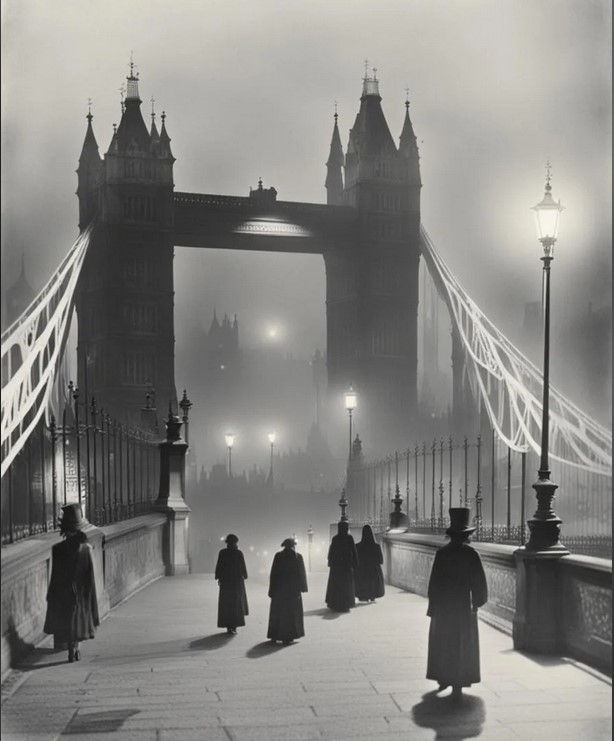Lambeth Bridge: Difference between revisions
No edit summary |
No edit summary |
||
| Line 1: | Line 1: | ||
;'''[[London]]''' | ;'''[[London]]''' | ||
;[[File:Lambeth Bridge at night 1900.jpg]] | |||
Lambeth Bridge is a road traffic and footbridge crossing the River Thames in an east–west direction in central London. The river flows north at the crossing point. Downstream, the next bridge is Westminster Bridge; upstream, the next bridge is Vauxhall Bridge. | Lambeth Bridge is a road traffic and footbridge crossing the River Thames in an east–west direction in central London. The river flows north at the crossing point. Downstream, the next bridge is Westminster Bridge; upstream, the next bridge is Vauxhall Bridge. | ||
The most conspicuous | The most conspicuous color in the bridge's paint scheme is red, the same color as the leather benches in the House of Lords, which is at the southern end of the Palace of Westminster nearest the bridge. This is in contrast to Westminster Bridge, which is predominantly green, the same color as the benches in the House of Commons at the northern end of the Houses of Parliament. | ||
On the east side, in Lambeth, are Lambeth Palace, the Albert Embankment, St. Thomas' Hospital, and the International Maritime Organization. On the west side, in Westminster, are Thames House (the headquarters of MI5), behind which is Horseferry House (the National Probation Service headquarters), and Clelland House and Abell House (the headquarters of HM Prison Service), and the Millbank Tower and Tate Britain. The Palace of Westminster is a short walk downstream to the north through the Victoria Tower Garden. | On the east side, in Lambeth, are Lambeth Palace, the Albert Embankment, St. Thomas' Hospital, and the International Maritime Organization. On the west side, in Westminster, are Thames House (the headquarters of MI5), behind which is Horseferry House (the National Probation Service headquarters), and Clelland House and Abell House (the headquarters of HM Prison Service), and the Millbank Tower and Tate Britain. The Palace of Westminster is a short walk downstream to the north through the Victoria Tower Garden. | ||
Lambeth Bridge is on the site of a horse ferry between the Palace of Westminster and Lambeth Palace on the south bank. | ==History== | ||
Lambeth Bridge is on the site of a horse ferry between the Palace of Westminster and Lambeth Palace on the south bank. Its name lives on in Horseferry Road, which forms the approach to the bridge on the north bank. | |||
The first modern bridge was a suspension bridge, 828 feet (252.4 m) long, designed by Peter W. Barlow. Sanctioned by an Act of Parliament in 1860, it opened as a toll bridge on 10 November 1862. | The first modern bridge was a suspension bridge, 828 feet (252.4 m) long, designed by Peter W. Barlow. Sanctioned by an Act of Parliament in 1860, it opened as a toll bridge on 10 November 1862. Doubts about its safety, coupled with its awkwardly steep approaches deterring horse-drawn traffic, meant it soon became used almost solely as a pedestrian crossing. It ceased to be a toll bridge in 1879 when the Metropolitan Board of Works assumed responsibility for its upkeep — it was by then severely corroded, and by 1910 it was closed to vehicular traffic. | ||
Latest revision as of 16:56, 8 June 2024
Lambeth Bridge is a road traffic and footbridge crossing the River Thames in an east–west direction in central London. The river flows north at the crossing point. Downstream, the next bridge is Westminster Bridge; upstream, the next bridge is Vauxhall Bridge.
The most conspicuous color in the bridge's paint scheme is red, the same color as the leather benches in the House of Lords, which is at the southern end of the Palace of Westminster nearest the bridge. This is in contrast to Westminster Bridge, which is predominantly green, the same color as the benches in the House of Commons at the northern end of the Houses of Parliament.
On the east side, in Lambeth, are Lambeth Palace, the Albert Embankment, St. Thomas' Hospital, and the International Maritime Organization. On the west side, in Westminster, are Thames House (the headquarters of MI5), behind which is Horseferry House (the National Probation Service headquarters), and Clelland House and Abell House (the headquarters of HM Prison Service), and the Millbank Tower and Tate Britain. The Palace of Westminster is a short walk downstream to the north through the Victoria Tower Garden.
History
Lambeth Bridge is on the site of a horse ferry between the Palace of Westminster and Lambeth Palace on the south bank. Its name lives on in Horseferry Road, which forms the approach to the bridge on the north bank.
The first modern bridge was a suspension bridge, 828 feet (252.4 m) long, designed by Peter W. Barlow. Sanctioned by an Act of Parliament in 1860, it opened as a toll bridge on 10 November 1862. Doubts about its safety, coupled with its awkwardly steep approaches deterring horse-drawn traffic, meant it soon became used almost solely as a pedestrian crossing. It ceased to be a toll bridge in 1879 when the Metropolitan Board of Works assumed responsibility for its upkeep — it was by then severely corroded, and by 1910 it was closed to vehicular traffic.
